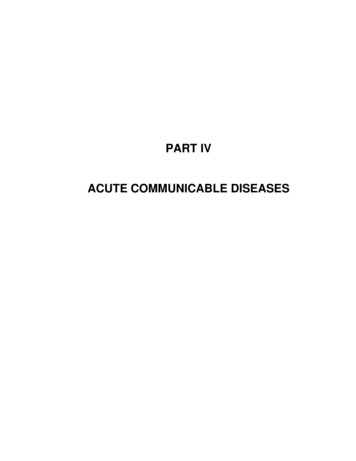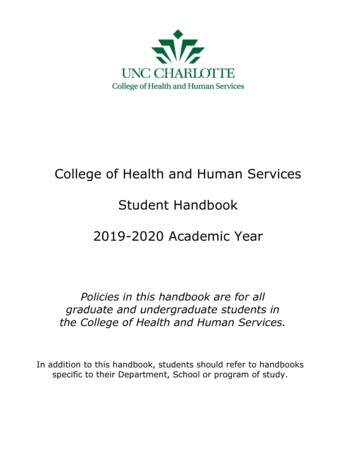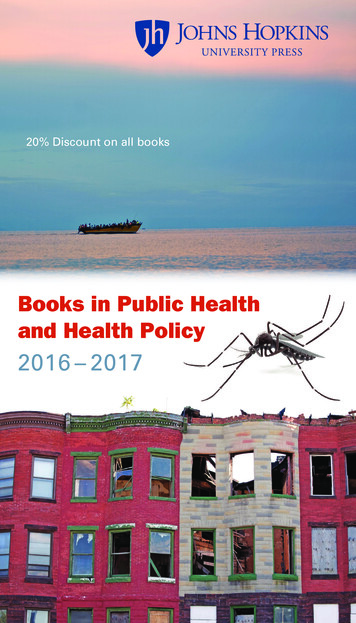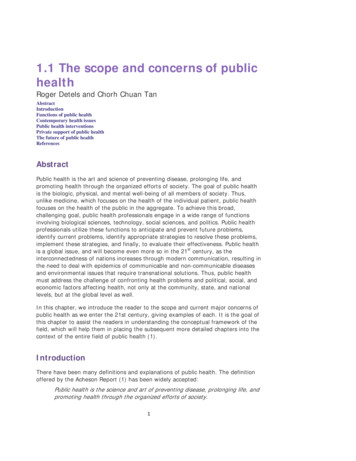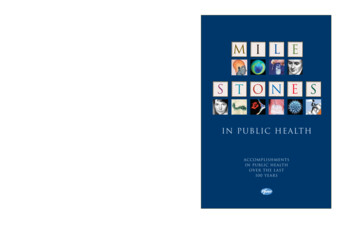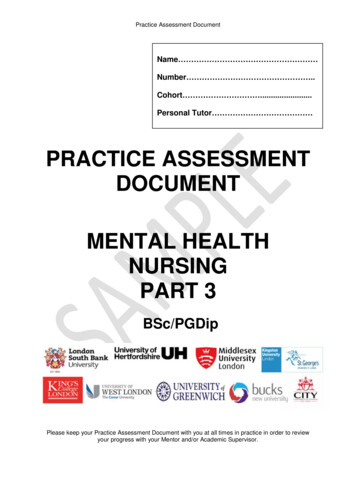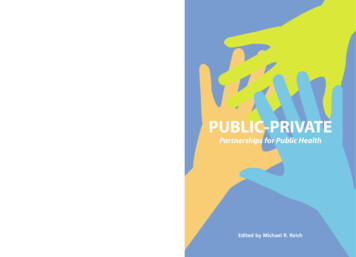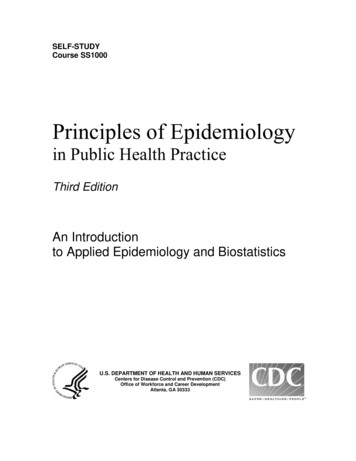
Transcription
SELF-STUDYCourse SS1000Principles of Epidemiologyin Public Health PracticeThird EditionAn Introductionto Applied Epidemiology and BiostatisticsU.S. DEPARTMENT OF HEALTH AND HUMAN SERVICESCenters for Disease Control and Prevention (CDC)Office of Workforce and Career DevelopmentAtlanta, GA 30333
CONTENTSAcknowledgments.vIntroduction. viiiLesson One: Introduction to EpidemiologyLesson Introduction . 1-1Lesson Objectives . 1-1Major SectionsDefinition of Epidemiology . 1-2Historical Evolution of Epidemiology . 1-7Uses. 1-12Core Epidemiologic Functions . 1-15The Epidemiologic Approach . 1-21Descriptive Epidemiology . 1-31Analytic Epidemiology . 1-46Concepts of Disease Occurrence . 1-52Natural History and Spectrum of Disease. 1-59Chain of Infection . 1-62Epidemic Disease Occurrence . 1-72Summary . 1-80Exercise Answers. 1-81Self-Assessment Quiz . 1-85Answers to Self-Assessment Quiz . 1-90References. 1-93Lesson Two: Summarizing DataLesson Introduction . 2-1Lesson Objectives . 2-1Major SectionsOrganizing Data . 2-2Types of Variables . 2-3Frequency Distributions. 2-6Properties of Frequency Distributions . 2-10Methods for Summarizing Data. 2-14Measures of Central Location. 2-15Measures of Spread. 2-35Choosing the Right Measure of Central Location and Spread . 2-52Summary . 2-58Exercise Answers. 2-59Self-Assessment Quiz . 2-65Answers to Self-Assessment Quiz . 2-70References. 2-72IntroductionPage ii
Lesson Three: Measures of RiskLesson Introduction . 3-1Lesson Objectives . 3-1Major SectionsFrequency Measures . 3-2Morbidity Frequency Measures . 3-10Mortality Frequency Measures . 3-20Natality (Birth) Measures . 3-38Measures of Association . 3-38Measures of Public Health Impact. 3-47Summary . 3-50Exercise Answers. 3-51Self-Assessment Quiz . 3-55Answers to Self-Assessment Quiz . 3-61References. 3-64Lesson Four: Displaying Public Health DataLesson Introduction . 4-1Lesson Objectives . 4-1Major SectionsIntroduction to Tables and Graphs. 4-2Tables. 4-3Graphs . 4-22Other Data Displays. 4-42Using Computer Technology. 4-63Summary . 4-66Exercise Answers. 4-72Self-Assessment Quiz . 4-80Answers to Self-Assessment Quiz . 4-85References. 4-88Lesson Five: Public Health SurveillanceLesson Introduction . 5-1Lesson Objectives . 5-1Major SectionsIntroduction. 5-2Purpose and Characteristics of Public Health Surveillance. 5-3Identifying Health Problems for Surveillance . 5-4Identifying or Collecting Data for Surveillance. 5-11Analyzing and Interpreting Data. 5-21Disseminating Data and Interpretation . 5-32Evaluating and Improving Surveillance. 5-36Summary . 5-40Appendix A. Characteristics of Well-Conducted Surveillance . 5-41IntroductionPage iii
Appendix B.Appendix C.Appendix D.Appendix E.CDC Fact Sheet on Chlamydia . 5-43Examples of Surveillance . 5-46Major Health Data Systems in the United States. 5-50Limitations of Notifiable Disease Surveillance andRecommendations for Improvement. 5-51Exercise Answers. 5-55Self-Assessment Quiz . 5-61Answers to Self-Assessment Quiz . 5-66References. 5-71Lesson Six: Investigating an OutbreakLesson Introduction . 6-1Lesson Objectives . 6-1Major Sections:Introduction to Investigating an Outbreak . 6-2Steps of an Outbreak Investigation . 6-8Summary . 6-57Exercise Answers. 6-59Self-Assessment Quiz . 6-65Answers to Self-Assessment Quiz . 6-72References. 6-76GlossaryIntroductionPage iv
ACKNOWLEDGMENTSDeveloped byU.S. Department of Health and Human ServicesCenters for Disease Control and Prevention (CDC)Office of Workforce and Career Development (OWCD)Career Development Division (CDD)Atlanta, Georgia 30333Technical ContentRichard Dicker, MD, MSc., Lead Author, CDC/OWCD/CDD (retired)Fátima Coronado, MD, MPH, CDC/OWCD/CDDDenise Koo, MD, MPH, CDC/OWCD/CDDRoy Gibson Parrish, II, MD (contractor)Development TeamSonya Arundar, MS, CDC (contractor)Cassie Edwards, CDC (contractor)Nancy Hunt, MPH, CDC (contractor)Ron Teske, MS, CDC (contractor)Susan Baker Toal, MPH, Public Health Consultant (contractor)Susan D. Welch, M.Ed., Georgia Poison CenterPlanning CommitteeChris Allen, RPh, MPH, CDCWalter Daley, DVM, MPH, CDCPat Drehobl, RN, MPH, CDCSharon Hall, RN, PhD, CDCDennis Jarvis, MPH, CHES, CDCDenise Koo, MD, MPH, CDCGraphics/IllustrationsSonya Arundar, MS, CDC (contractor)Lee Oakley, CDC (retired)Jim Walters, CDC (contractor)Technical ReviewersTomas Aragon, MD, DrPH, UC Berkeley Center for Infectious Disease PreparednessDiane Bennett, MD, MPH, CDCDanae Bixler, MD, MPH, West Virginia Bureau for Public HealthR. Elliot Churchill, MS, MA, CDC (retired)Roxanne Ereth, Arizona Department of Health ServicesStephen Everett, MPH, Yavapai County Community Health Services, ArizonaIntroductionPage v
Michael Fraser, PhD., National Association of County and City Health OfficialsNancy Gathany, M. Ed., CDCMarjorie A.Getz, MPHIL, Bradley University, IllinoisJohn Mosely Hayes, DrPH, MBA, MSPH, Tribal Epidemiology Center United South andEastern Tribes, Inc., TennesseeRichard Hopkins, MD, MSPH, Florida Department of HealthJohn M. Horan, MD, MPH, Georgia Division of Public HealthChristy Bruton Kwon, MSPH, SAICEdmond F. Maes, PhD, CDCSharon McDonnell, MD, MPH, Darmouth Medical SchoolWilliam S. Paul, MD, MPH, Chicago Department of Public HealthJames Ransom, MPH, National Association of County and City Health OfficialsLynn Steele, MS, CDCDonna Stroup, PhD., MSc., American Cancer SocietyDouglas A. Thoroughman, PhD, CDCKirsten Weiser, MD, Darmouth Hitchcock Medical SchoolCelia Woodfill, PhD, California Department of Health ServicesField Test ParticipantsSean Altekruse, DVM, MPH, PhD, United States Department of AgricultureGwen Barnett, MPH, CHES, CDCJason Bell, MD, MPHLisa Benaise, MD, CDCAmy Binggeli, DrPH, RD, CHES, CLE, Imperial County Public Health Department,CaliforniaKim M. Blindauer, DVM, MPH, ATSDRRandy Bong, RN, Federal Bureau of PrisonsJohnna Burton, BS, CHES, Tennessee Department of HealthCatherine C.Chow, MD, MPH, CDCJanet Cliatt, MT., CLS (NCA), National Institutes of HealthCatherine Dentinger, FNP, MS, NYC Department of Health and Mental HygieneVeronica Gordon, RN, BSN, MS, Indian Health Service, New MexicoSue Gorman, Pharm. D., CDCDeborah Gould, PhD., CDCJuliana Grant, MD, CDCLori Evans Hall, Pharm. D., CDCNazmul Hassan, MS, Food and Drug AdministrationDaniel L. Holcomb, ATSDRAsim A. Jani, MD, MPH FACP, CDCJean Jones, RN, CDCCharletta Lewis, BSN, Wellpinit Indian Health Service, WashingtonSheila F. Mahoney, CNM., MPH, National Institutes of HealthCassandra Martin, MPH, CHES, Georgia Department of Human ResourcesJoan Marie McFarland, RN, PHN, Winslow Indian Health Care Center, ArizonaRosemarie McIntyre, RN, MS, CHES, CDCIntroductionPage vi
Gayle L. Miller, DVM, PhD(c), Jefferson County Department of Health andEnvironment, MissouriLong S. Nguyen, MPH, CHES, CDC (contractor)Paras M. Patel, R.Ph., Food and Drug AdministrationRossanne M. Philen, MD, MS, CDCAlyson Richmond, MPH, CHES, CDC (contractor)Glenna A. Schindler, MPH, RN, CHES, MissouriSandra Schumacher, MD, MPH, CDCJulie R.Sinclair, DVM, MPH, CDCNita Sood, R.Ph., Pharm.D., Health Resources and Services AdministrationP. Lynne Stockton, VMD, MS, CDCJill B. Surrency, MPH, CHES, CDC (contractor)Joyce K. Witt, RN, CDCIntroductionPage vii
INTRODUCTIONThis course was developed by the Centers for Disease Control and Prevention (CDC) as aself-study course. Continuing education credits are offered for certified public healtheducators, nurses, physicians, pharmacists, veterinarians, and public health professionals.CE credit is available only through the CDC/ATSDR Training and Continuing EducationOnline system at www.cdc.gov/phtnonline.To receive CE credit, you must register for the course (SS1000) and complete theevaluation and examination online. You must achieve a score of 70% or higher to passthe examination. If you do not pass the first time, you can take the exam a second time.For more information about continuing education, call 1-800-41TRAIN (1-800-4187246) or by e-mail at ce@cdc.gov.Course DesignThis course covers basic epidemiology principles, concepts, and procedures useful in thesurveillance and investigation of health-related states or events. It is designed for federal,state, and local government health professionals and private sector health professionalswho are responsible for disease surveillance or investigation. A basic understanding ofthe practices of public health and biostatistics is recommended.Course MaterialsThe course materials consist of six lessons. Each lesson presents instructional textinterspersed with relevant exercises that apply and test knowledge and skills gained.Lesson One: Introduction to EpidemiologyKey features and applications of descriptive and analytic epidemiologyLesson Two: Summarizing DataCalculation and interpretation of mean, median, mode, ranges, variance, standarddeviation, and confidence intervalLesson Three: Measures of RiskCalculation and interpretation of ratios, proportions, incidence rates, mortality rates,prevalence, and years of potential life lostLesson Four: Displaying Public Health DataPreparation and application of tables, graphs, and charts such as arithmetic-scale line,histograms, pie chart, and box plotLesson Five: Public Health SurveillanceProcesses, uses, and evaluation of public health surveillance in the United StatesIntroductionPage viii
Lesson Six: Investigating an OutbreakSteps of an outbreak investigationA Glossary that defines the major terms used in the course is also provided at the end ofLesson Six.Supplementary MaterialsIn addition to the course materials, students may want to use the following: A calculator with square root and logarithmic functions for some of the exercises. A copy of Heymann, DL, ed. Control of Communicable Diseases Manual, 18thedition, 2004, for reference. Available from the American Public Health Association(202) 777-2742.ObjectivesStudents who successfully complete this course should be able to correctly: Describe key features and applications of descriptive and analytic epidemiology. Calculate and interpret ratios, proportions, incidence rates, mortality rates,prevalence, and years of potential life lost. Calculate and interpret mean, median, mode, ranges, variance, standard deviation, andconfidence interval. Prepare and apply tables, graphs, and charts such as arithmetic-scale line, scatterdiagram, pie chart, and box plot. Describe the processes, uses, and evaluation of public health surveillance. Describe the steps of an outbreak investigation.General InstructionsSelf-study courses are “self-paced.” We recommend that a lesson be completed withintwo weeks. To get the most out of this course, establish a regular time and method ofstudy. Research has shown that these factors greatly influence learning ability.Each lesson in the course consists of reading, exercises, and a self-assessment quiz.Reading AssignmentsComplete the assigned reading before attempting to answer the self-assessment questions.Read thoroughly and re-read for understanding as necessary. A casual reading may resultin missing useful information which supports main themes. Assignments are designed tocover one or two major subject areas. However, as you progress, it is often necessary tocombine previous learning to accomplish new skills. A review of previous lessons maybe necessary. Frequent visits to the Glossary may also be useful.ExercisesExercises are included within each lesson to help you apply the lesson content. Someexercises may be more applicable to your workplace and background than others. Youshould review the answers to all exercises since the answers are very detailed. Answers toIntroductionPage ix
the exercises can be found at the end of each lesson. Your answers to these exercises arevaluable study guides for the final examination.Self-Assessment QuizzesAfter completing the reading assignment, answer the self-assessment quizzes beforecontinuing to the next lesson. Answers to the quizzes can be found at the end of thelesson. After passing all six lesson quizzes, you should be prepared for the finalexamination. Self-assessment quizzes are open book Unless otherwise noted, choose ALL CORRECT answers. Do not guess at the answer You should score at least 70% correct before continuing to the next lesson.Tips for Answering Questions Carefully read the question.Note that it may ask, “Which is CORRECT?” as well as “Which is NOTCORRECT?” or “Which is the EXCEPTION?”Read all the choices given.One choice may be a correct statement, but another choice may be more nearlycorrect or complete for the question that is asked.Final Examination and Course EvaluationThe final examination and course evaluation are available only on-line. The finalrequirement for the course is an open-book examination. We recommend that youthoroughly review the questions included with each lesson before completing the exam.It is our sincere hope that you will find this undertaking to be a profitable and satisfyingexperience. We solicit your constructive criticism at all times and ask that you let usknow whenever you have problems or need assistance.IntroductionPage x
Continuing Education CreditTo receive continuing education credit for completing the self-study course, go to theCDC/ATSDR Training and Continuing Education Online athttp://www.cdc.gov/phtnonline and register as a participant. (For individuals interested inobtaining RACE credit please contact the CDC Continuing Education office for details,1-800-41TRAIN or ce@cdc.gov.) You will need to register for the course (SS1000) andcomplete the course evaluation and exam online. You will have to answer at least 70% ofthe exam questions correctly to receive credit and to be awarded CDC’s certificate ofsuccessful completion. For more information about continuing education credits, pleasecall 1-800-41TRAIN (1-800-418-7246).Continuing Education Accreditation StatementsThe Centers for Disease Control and Prevention is accredited by the AccreditationCouncil for Continuing Medical Education (ACCME) to provide continuing medicaleducation for physicians.The Centers for Disease Control and Prevention designates this educational activity for amaximum of 17 category 1 credits toward the AMA Physician's Recognition Award.Each physician should claim only those credits that he/she actually spent in the activity. This activity for 17 contact hours is provided by the Centers for Disease Control andPrevention, which is accredited as a provider of continuing education in nursing by theAmerican Nurses Credentialing Center's Commission on Accreditations. The Centers for Disease Control and Prevention is a designated provider of continuingeducation contact hours (CECH) in health education by the National Commission forHealth Education Credentialing, Inc. This program is a designated event for the CHES toreceive 17 Category I contact hours in health education, CDC provider number GA0082. CDC is accredited by the Accreditation Council for Pharmacy Education as a provider ofcontinuing pharmacy education.This program is a designated event for pharmacists to receive 17 Contact Hours (1.7CEUs) in pharmacy education. The Universal Program Number is 387-000-06-035-H04.IntroductionPage xi
The Centers for Disease Control and Prevention has been approved as an AuthorizedProvider of continuing education and training programs by the International Associationfor Continuing Education and Training and awards 1.7 Continuing Education Units(CEUs). This program was reviewed and approved by the AAVSB RACE program for continuingeducation. Please contact the AAVSB RACE program at race@aavsb.org should youhave any comments/concerns regarding this program’s validity or relevancy to theveterinary profession.Course EvaluationEven if you are not interested in continuing education credits, we still encourage you tocomplete the course evaluation. To do this, go to http://www.cdc.gov/phtonline andregister as a participant. You will then need to register for the course (SS1000) andcomplete the course evaluation online. Your comments are valuable to us and will help torevise the self-study course in the future.Ordering InformationA hard-copy of the text can be obtained from the Public Health Foundation. Specify ItemNo. SS-1000 when ordering. Online at: http://bookstore.phf.org By phone:toll free within the US: 877-252-1200international: 301-645-7773. By fax at 301-843-0159 or 202-218-4409 to the attention of Publication Sales. By mail:PHF Publication SalesPO Box 753Waldorf, MD 20604IntroductionPage xii
1INTRODUCTION TO EPIDEMIOLOGYRecently, a news story described an inner-city neighborhood’s concernabout the rise in the number of children with asthma. Another storyreported the revised recommendations for who should receive influenzavaccine this year. A third story discussed the extensive disease-monitoringstrategies being implemented in a city recently affected by a massivehurricane. A fourth story described a finding published in a leadingmedical journal of an association in workers exposed to a particular chemical and an increasedrisk of cancer. Each of these news stories included interviews with public health officials orresearchers who called themselves epidemiologists. Well, who are these epidemiologists, andwhat do they do? What is epidemiology? This lesson is intended to answer those questions bydescribing what epidemiology is, how it has evolved and how it is used today, and what some ofthe key methods and concepts are. The focus is on epidemiology in public health practice, that is,the kind of epidemiology that is done at health departments.ObjectivesAfter studying this lesson and answering the questions in the exercises, you will be able to: Define epidemiology Summarize the historical evolution of epidemiology Name some of the key uses of epidemiology Identify the core epidemiology functions Describe primary applications of epidemiology in public health practice Specify the elements of a case definition and state the effect of changing the value of anyof the elements List the key features and uses of descriptive epidemiology List the key features and uses of analytic epidemiology List the three components of the epidemiologic triad Describe the different modes of transmission of communicable disease in a populationMajor SectionsDefinition of Epidemiology . 1-2Historical Evolution of Epidemiology . 1-7Uses. 1-12Core Epidemiologic Functions . 1-15The Epidemiologic Approach . 1-21Descriptive Epidemiology . 1-31Analytic Epidemiology . 1-46Concepts of Disease Occurrence . 1-52Natural History and Spectrum of Disease. 1-59Chain of Infection . 1-62Epidemic Disease Occurrence . 1-72Summary . 1-80Introduction to EpidemiologyPage 1-1
Definition of EpidemiologyStudents of journalism aretaught that a good newsstory, whether it be abouta bank robbery, dramaticrescue, or presidentialcandidate’s speech, mustinclude the 5 W’s: what,who, where, when andwhy (sometimes cited aswhy/how). The 5 W’s arethe essential componentsof a news story because ifany of the five aremissing, the story isincomplete.The same is true incharacterizingepidemiologic events,whether it be an outbreakof norovirus among cruiseship passengers or the useof mammograms to detectearly breast cancer. Thedifference is thatepidemiologists tend touse synonyms for the 5W’s: diagnosis or healthevent (what), person(who), place (where), time(when), and causes, riskfactors, and modes oftransmission (why/how).The word epidemiology comes from the Greek words epi, meaningon or upon, demos, meaning people, and logos, meaning the studyof. In other words, the word epidemiology has its roots in the studyof what befalls a population. Many definitions have been proposed,but the following definition captures the underlying principles andpublic health spirit of epidemiology:Epidemiology is the study of the distribution anddeterminants of health-related states or events in specifiedpopulations, and the application of this study to the controlof health problems.1Key terms in this definition reflect some of the importantprinciples of epidemiology.StudyEpidemiology is a scientific discipline with sound methods ofscientific inquiry at its foundation. Epidemiology is data-drivenand relies on a systematic and unbiased approach to the collection,analysis, and interpretation of data. Basic epidemiologic methodstend to rely on careful observation and use of valid comparisongroups to assess whether what was observed, such as the numberof cases of disease in a particular area during a particular timeperiod or the frequency of an exposure among persons withdisease, differs from what might be expected. However,epidemiology also draws on methods from other scientific fields,i
surveillance and investigation of health-related states or events. It is designed for federal, state, and local government health professionals and private sector health professionals who are responsible for disease surveillance or investigation. A basic understanding of the practices of


